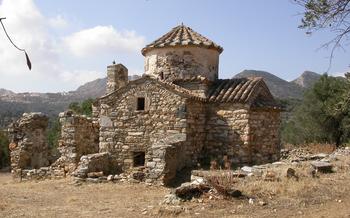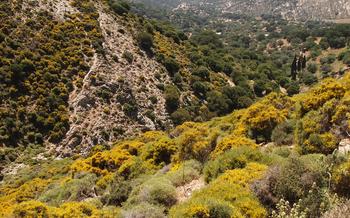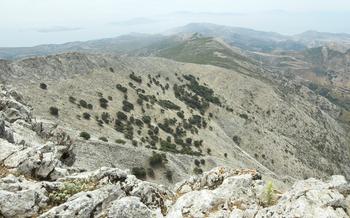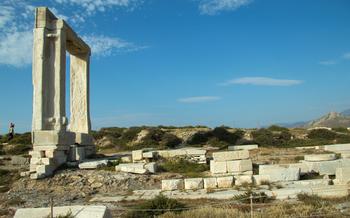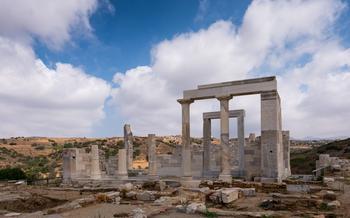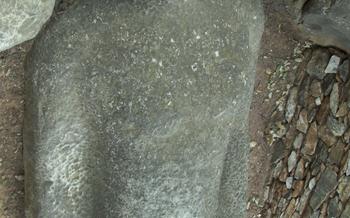
Naxos Aqueduct
- Historical Significance
- Location and Accessibility: Unveiling the Path to History
- Architectural Features
- Historical Context
- Preservation and Restoration: Ensuring the Legacy of the Naxos Aqueduct
- Panoramic Views
- Hiking and Exploration
- Nearby Attractions
- Photography Opportunities
- Guided Tours
- Accessibility for Visitors
- Local Cuisine and Dining
- Souvenirs and Local Crafts
- Insider Tip:
Historical Significance
The Naxos Aqueduct stands as a testament to the ingenuity and engineering prowess of ancient Greece. Constructed in the 6th century BC, this remarkable structure played a pivotal role in providing a reliable water supply to the flourishing city of Naxos. The aqueduct's impressive length of over 3 kilometers showcased the determination and perseverance of its builders, who painstakingly carved channels through solid rock and constructed sturdy arches to support the water's flow. The aqueduct's construction materials, primarily local stone and marble, demonstrated the builders' commitment to durability and longevity. This ancient marvel not only served a practical purpose but also embodied the cultural and architectural achievements of the Naxian civilization, leaving an enduring legacy for generations to come.
Location and Accessibility: Unveiling the Path to History
The Naxos Aqueduct stands as a majestic testament to ancient engineering, inviting visitors to embark on a journey through time. Located in the picturesque village of Eggares, approximately 6 kilometers from Naxos Town, the aqueduct is easily accessible by car or public transportation. Follow the road leading out of town towards the village of Filoti and turn left at the sign for Eggares. The aqueduct is situated just outside the village, where visitors can park their vehicles and begin their exploration.
For those relying on public transportation, buses depart regularly from Naxos Town to Eggares, providing a convenient and affordable option. Once in Eggares, inquire with the locals for directions to the aqueduct, as it is within easy walking distance from the village center.
Combining a visit to the Naxos Aqueduct with other attractions in the area is a rewarding experience. The nearby village of Filoti offers a glimpse into traditional Naxian life, with its charming whitewashed houses, narrow streets, and local tavernas serving authentic Greek cuisine. The Temple of Demeter, located just a short drive from the aqueduct, is another significant historical site worth exploring, providing insights into the religious beliefs and practices of ancient Naxos.
Architectural Features
The Naxos Aqueduct stands as a testament to the ingenuity and skill of ancient Greek engineers. Constructed entirely of local stone, without the use of mortar or cement, the aqueduct stretches for over 3 kilometers, carrying water from the mountainous region of Tragea to the ancient city of Naxos. Its imposing structure features a series of arches that support the water channels, allowing the water to flow at a gentle gradient. The arches, which vary in size and shape, are a striking architectural feature, demonstrating the builders' mastery of arch construction. The aqueduct's buttresses, strategically positioned along its length, provide additional support and stability, ensuring the structure's longevity. These architectural elements not only serve a functional purpose but also contribute to the aqueduct's overall aesthetic appeal, making it a masterpiece of ancient engineering.
Historical Context
The Naxos Aqueduct stands as a testament to the ingenuity and engineering prowess of the ancient Naxians. Built in the 6th century BC, the aqueduct played a crucial role in the development and prosperity of the island. It was commissioned by the tyrant Lygdamis, who sought to provide a reliable water supply to the growing population of Naxos Town. The aqueduct channeled water from mountain springs located several kilometers away, ensuring a consistent flow of fresh water to the city's households, public fountains, and agricultural fields.
The aqueduct's construction involved meticulous planning and skilled craftsmanship. The ancient Naxians utilized local materials, such as limestone and marble, to create a durable and efficient water transportation system. The aqueduct's design incorporated a series of arches and buttresses to support its weight and withstand the natural elements. Its intricate construction methods and impressive scale showcase the advanced engineering knowledge of the ancient Greeks.
The Naxos Aqueduct served as a lifeline for the island's inhabitants for centuries. It facilitated the growth of agriculture, trade, and urban development, contributing to the overall prosperity of Naxos. The aqueduct's presence also played a significant role in shaping the island's cultural identity, as it symbolized the ingenuity and resourcefulness of the Naxian people.
Preservation and Restoration: Ensuring the Legacy of the Naxos Aqueduct
Over the centuries, the Naxos Aqueduct has faced the relentless passage of time and the elements. Recognizing its historical and cultural significance, concerted efforts have been made to preserve and restore this ancient marvel for future generations.
In recent years, the Greek government has undertaken several restoration projects aimed at safeguarding the structural integrity and historical value of the aqueduct. These projects have involved meticulous cleaning and repair of the stonework, consolidation of weakened sections, and reinforcement of the supporting arches and buttresses.
To ensure the longevity of the aqueduct, responsible tourism practices are paramount. Visitors are encouraged to tread carefully, refrain from climbing on the structure, and avoid littering or causing any damage to the surrounding environment. By respecting and preserving this ancient treasure, we can ensure that its legacy continues to inspire and captivate visitors for generations to come.
Panoramic Views
The Naxos Aqueduct offers breathtaking panoramic views that will leave you in awe. From the top of the aqueduct or along its path, you can capture stunning photographs of the surrounding landscape, including Naxos Town, the Aegean Sea, and nearby islands. The aqueduct provides a unique vantage point to appreciate the beauty and diversity of Naxos. Whether you're a professional photographer or simply someone who loves taking pictures, the Naxos Aqueduct is a must-visit destination.
To make the most of your visit, plan your trip around the lighting conditions. The best time to visit the aqueduct for photography is during the golden hours, just after sunrise or before sunset, when the warm light casts a magical glow over the landscape. Additionally, try to visit on a clear day when visibility is at its best. This will allow you to capture crisp and vibrant shots of the aqueduct and its surroundings.
Hiking and Exploration
For those seeking a more active experience, the Naxos Aqueduct offers a unique opportunity to combine history and nature through hiking. The path that runs alongside the aqueduct invites visitors to embark on a journey of exploration, immersing themselves in the beautiful surroundings. The level of difficulty is considered easy to moderate, making it accessible to hikers of all skill levels. The distance of the trail can be customized based on personal preferences, allowing visitors to choose a route that suits their time and fitness level.
Before embarking on the hike, it's essential to come prepared with appropriate footwear, sun protection, and a sufficient supply of water. The path offers stunning views of the surrounding countryside, including the picturesque villages, olive groves, and the shimmering Aegean Sea in the distance. Along the way, hikers can discover hidden nooks, encounter local flora and fauna, and enjoy moments of tranquility amidst nature.
Combining the hike with a visit to nearby attractions can create a comprehensive and enriching experience. The Temple of Demeter, located just a short distance from the aqueduct, is a significant archaeological site that offers a glimpse into the island's ancient past. Visitors can delve into the history and mythology surrounding this sacred place, adding another layer to their exploration of Naxos.
Nearby Attractions
The Naxos Aqueduct is conveniently located amidst a wealth of other historical and natural attractions, allowing visitors to create a comprehensive itinerary for exploring the area. Just a short walk away is the charming village of Chalki, with its narrow cobbled streets, whitewashed houses, and traditional tavernas. Visitors can immerse themselves in the local culture, sample delicious Greek cuisine, and visit the nearby Folk Museum to learn about Naxos' rich history and traditions.
For those seeking a spiritual experience, the Panagia Drosiani Church, located a few kilometers from the aqueduct, is a must-visit. This early Christian basilica dates back to the 6th century and is considered one of the most significant Byzantine monuments in Greece. Its well-preserved mosaics and frescoes offer a glimpse into the artistic and religious heritage of Naxos.
Nature enthusiasts will delight in exploring the nearby Koufonisia islets, a group of uninhabited islands just a short boat ride from Naxos. These pristine islands boast crystal-clear waters, secluded beaches, and a diverse marine ecosystem. Visitors can enjoy swimming, snorkeling, and diving in the crystal-clear waters, or simply relax on the unspoiled shores and soak up the Mediterranean sun.
To delve deeper into Naxos' ancient past, visitors can visit the Archaeological Museum of Naxos, located in the island's capital, Naxos Town. The museum houses a collection of artifacts from various archaeological sites on the island, including pottery, sculptures, and inscriptions. These exhibits provide a fascinating glimpse into the rich history and cultural heritage of Naxos, from the Neolithic period to the Byzantine era.
By combining a visit to the Naxos Aqueduct with these nearby attractions, visitors can create a memorable and enriching experience that encompasses history, culture, nature, and local traditions, ensuring a truly immersive exploration of this beautiful island.
Photography Opportunities
The Naxos Aqueduct presents a myriad of captivating photo opportunities for photography enthusiasts. Its imposing structure, set against the backdrop of the azure Aegean Sea and the verdant Naxian landscape, creates a picturesque panorama that begs to be captured. With its intricate arches, weathered stonework, and panoramic vistas, the aqueduct offers endless possibilities for stunning shots.
Photographers can experiment with various angles and perspectives to capture the aqueduct's grandeur. The best shots can be obtained by shooting from different vantage points along the path, allowing for dramatic compositions that showcase the aqueduct's scale and its integration with the natural surroundings.
To capture the most vibrant hues, photographers should consider visiting the aqueduct during the golden hours of sunrise or sunset, when the warm light casts a magical glow on the ancient structure. Additionally, using a tripod and a wide-angle lens can help photographers capture the vastness of the aqueduct and the surrounding landscape.
Whether you are a seasoned professional or an amateur photographer, the Naxos Aqueduct promises a rewarding experience, providing ample opportunities to capture stunning images that will serve as lasting mementos of your visit to this historical marvel.
Guided Tours
Guided tours of the Naxos Aqueduct offer an immersive and informative experience for visitors seeking a deeper understanding of its history, construction, and significance. Led by knowledgeable local guides, these tours provide fascinating insights into the ancient engineering techniques, cultural context, and historical importance of the aqueduct.
Guides share captivating stories and anecdotes that bring the aqueduct's past to life, highlighting its role in the development of Naxos and its enduring legacy. Visitors can ask questions, engage in discussions, and gain a comprehensive understanding of the aqueduct's place in Greek history and culture.
Guided tours typically cover the aqueduct's construction techniques, materials, and architectural features, as well as its impact on the island's water supply and economy. Visitors can learn about the ancient civilization that built the aqueduct and the challenges they faced in transporting water over long distances. Guided tours also often include visits to other nearby attractions, such as the Naxos Archaeological Museum or the Venetian Castle, providing a well-rounded exploration of the island's rich history and cultural heritage.
To book a guided tour of the Naxos Aqueduct, visitors can contact local tour operators or inquire at their hotel or accommodation for recommendations. Guided tours are available in various languages and offer a range of options to suit different interests and budgets. Whether you're a history buff, an architecture enthusiast, or simply curious to learn more about Naxos' past, a guided tour of the Naxos Aqueduct is an enriching experience that will enhance your appreciation for this remarkable ancient wonder.
Accessibility for Visitors
The Naxos Aqueduct is committed to providing an accessible and enjoyable experience for all visitors, regardless of their abilities. The site is equipped with ramps and handrails to ensure easy access for those with limited mobility. Designated parking spaces for disabled visitors are available nearby, and there are accessible restrooms on-site. Visitors with any specific accessibility needs are encouraged to contact the aqueduct's management in advance to ensure a smooth and enjoyable visit. The staff is always ready to assist and provide any necessary accommodations. Additionally, guided tours can be tailored to meet the needs of visitors with disabilities, providing a comprehensive and inclusive experience for all.
Local Cuisine and Dining
A visit to the Naxos Aqueduct can be complemented by a culinary journey through the flavors of Naxian cuisine. The island boasts a rich culinary tradition, influenced by its unique geographical location and historical interactions with diverse cultures.
Fresh seafood, caught daily from the crystal-clear waters of the Aegean Sea, forms the backbone of Naxian cuisine. Indulge in grilled octopus, succulent lobsters, or the iconic Naxian dish of kritharoto, a creamy risotto-like dish made with giant couscous, shrimp, and local herbs.
Naxos is also renowned for its artisanal cheeses, crafted from the milk of free-ranging goats and sheep that graze on the island's aromatic herbs. Sample the tangy mizithra, a soft, white cheese, or the sharper kefalotyri, a hard, yellow cheese perfect for grating over pasta or salads.
No culinary exploration of Naxos is complete without savoring the island's distinctive wines. The volcanic soil and unique microclimate produce grapes that yield aromatic and flavorful wines. Sip on a glass of Assyrtiko, a crisp white wine with citrus and mineral notes, or savor the robust red wine of Mandilaria, characterized by its deep color and spicy flavors.
To experience the authentic flavors of Naxos, venture beyond the tourist traps and seek out traditional tavernas or family-run restaurants. Engage with the locals, ask for recommendations, and immerse yourself in the warm hospitality that Naxos is known for. Indulge in a leisurely meal, savoring each bite as you soak in the charm and beauty of this enchanting island.
Souvenirs and Local Crafts
Visiting the Naxos Aqueduct offers an opportunity to take home a piece of the island's rich cultural heritage through souvenirs and local crafts. In the nearby shops and markets, visitors can find a variety of unique items inspired by the aqueduct and Naxian traditions. Replicas of ancient coins, handcrafted pottery, and intricate textiles are popular choices. These souvenirs serve as tangible reminders of the island's history and its enduring connection to the past. By supporting local artisans, visitors not only acquire meaningful mementos but also contribute to the preservation of Naxos' vibrant cultural identity.
Insider Tip:
For a truly unique experience, consider visiting the Naxos Aqueduct during the early morning hours. As the sun rises, the aqueduct casts a golden glow against the backdrop of the Aegean Sea, creating a breathtaking spectacle. This tranquil time of day offers an opportunity for peaceful contemplation and a chance to capture stunning photographs without the crowds. Moreover, the early morning light beautifully illuminates the intricate details of the aqueduct's architecture, making it an ideal time for photography enthusiasts to capture the essence of this ancient masterpiece.
